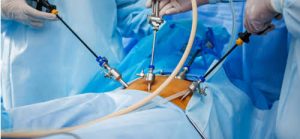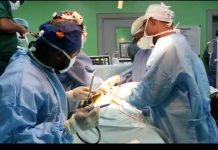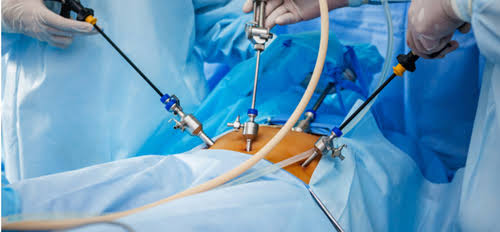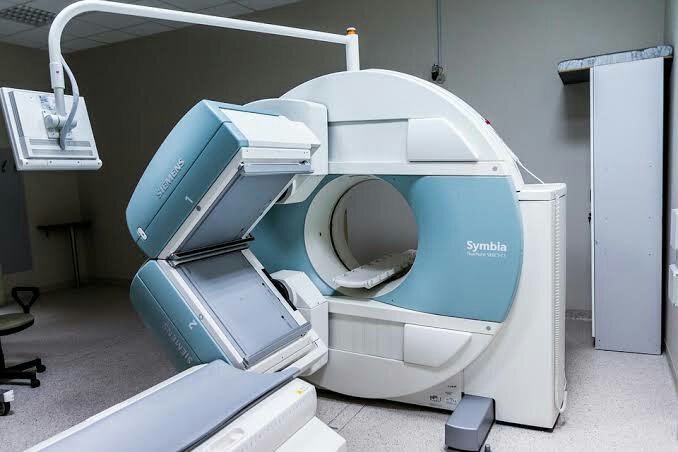An article on laparoscopy in Nigeria, laparoscopy test in Nigeria, laparoscopic surgery in Nigeria, laparoscopic surgery cost in Nigeria, cost of laparoscopy in Nigeria, laparoscopy in Lagos, laparoscopy price in Nigeria, laparoscopy centres in Nigeria, laparoscopy test cost in Nigeria, types, benefits and disadavantages of laparoscopy
Laparoscopy is the direct visualisation of the peritoneal/abdominal cavity and its contents. This is achieved by the placement of a telescope into the peritoneal cavity.

Laparoscopy also known and key-hole surgery is a type of minimally invasive surgery which has the advantages of mimimal cutting, little or ni bleeding, mimimal surgery scars, and quick recovery. Laparoscopy is however more expensive than open surgeries.
Because it is a potential space, vision is only possible by filling the cavity with gas (pneumoperitoneum). A video camera anached to the telescope permits viewing of the peritoneal cavity and its contents on a video screen (monilor). Trocars with their sheaths (5mm, 10mm or larger) are then introduced under vision.
The sheaths (poru) serve as channels through which instruments are introduced into the peritoneal cavity and procedures undertaken.
Tbere are special instruments used for laparoscopie surgery. Special training is also needed as the skills required are quite different from conventional surgery.
Some of the problems encountered with mastering the skill have to do with depth perception, 20 imaging and paradoxical hand movement.
The laparoscopic surgeon must, however, be conversant with conventional treatment because the procedure may need to be converted from laparoscopic to open surgery if the equipment fails, vision becomes impaired , the anatomy is
unclear or severe haemorrhage occurs.
Laparoscopy can be used in emergency and elective settings, and for both diagnosis and treatment.
Indications For Laparascopy (Situations where laparoscopy may be required)
Laparoscopy can be used for diagnostic or therapeutic purposes, in emergency as well as elective situations.
Diagnostic Laparoscopy
Performed simply to make a diagnosis of the numerous abdominal problems that may occur especially for acute or chronic abdominal pains, take biopsy of abdominal organs, to look at a diseased intra-abdominal organ and so on. This can be performed as an outpatient or in-patient procedure. Although usually general anaesthesia is used, it can be done under local anaesthesia with sedation.
Therapeutic Laparoscopy
This is done to treat. Surgical procedures may be performed wholly laparoscopically or laparoscopy-assisted, Starting with laparoscopic cholecystectomy, most abdominal operations bave been performed laparoscopically.
The benefits as determined by clinical outcome, patients’ reports and economic measures have however, not been proven for some procedures.
1. Laparoscopic Cholecystectomy (gall bladder removal surgery)
2. Laparoscopic Appendicectomy
3. Laparoscopic inguinal hernia repair
4. Laparosropic Nissen fundoplication especially for complicated reflux disease
5. Laparoscopic Heller’s cardiomvotomy: For patients with achalasia (blocked or paralysed esophagus), laparoscopic longitudinal cardiomyotomy has been shown to be effective, safe, and orten preferable to open surgery.
6. Laparoscopic Adrenalectomy
7. Laparoscopic splenectomy
8. Laparoscopic Colectomy
9. Laparoscopic myomectomy (laparoscopic fibroid surgery)
10. Laparoscopic hysterectomy (fibroid removal surgery)
11. Hand assisted surgery: This is also termed laparoscopically-assisted surgery. Laparoscopy minimises the size of the wound necessary for
dissection, mobilisation and resection.
12. Other surgical operations: Many other laparoscopic operations are under evaluation, i.e. there is no unanimity about the procedures being preferable to traditional approaches.
They include: laparoscopic nephrectomy (kidney removal surgery) and laparoscopic repair of duodenal perforation. There are certainly prospects for carrying out all operations laparoscopically or laparoscopically assisted.
Contraindications for Laparoscopy – Conditions where laparoscopy should not be performed
Many of the contraindications for laparoscopy are relative and depend on the severity of the conditions, the provision of adequate precautions and the experience of the surgeon. The conditions include:
➡️Bleeding disorders
➡️Peritonitis (inflammation of the abdominal cavity)
➡️Sepsis (infection) of the anterior abdominal wall
➡️Extreme obesity
➡️Adhesions
➡️Intestinal obstruction
Advantages of Laparoscopy
There are clear benefits to the patient who undergoes laparoscopic surgery. This is basically because there is less metabolic stress to the patient.
The benefits to the patient can be summarised thus:
💥Less postoperative pain
💥Early return of bowel function and early feeding
💥Reduced metabolic response to trauma
💥Fewer respiratory complications
💥Early mobilisation
💥Early discharge from hospital
💥Early return to work/norrnal activity
💥Smaller scars and better cosmetic results
💥Fewer wound complications e.g. wound break down
🔷Other advantages to the surgeon are that:
💥Magnification of struCtures makes strucrures better visualised.
💥It allows for inspection of inaccessible areas in the abdomen.
💥By having direct visual access to the monitor, real-time interaction is possible between the surgeon and assistants, thereby improving the efficiency of the operation.
💥Operations can be recorded fo r educational or research purposes.
💥Bed occupancy is reduced.
Disadvantages of Laparoscopy
💥It is capital intensive.
💥There is a high cost/low benefit ratio for many procedures.
💥There is the need for acquisition of completely different technical skills, with a steep learning curve.
💥Technical challenge: Visual depth appreciation in 3D images, hand-eye co·ordination, etc .
💥It permits assessment of only surface anatomy.
💥Lack of tactile feedback.
💥Manipulation of abdomina l viscera is more difficult and therefore makes certain procedures more technically demanding.
💥There may be limiled therapeutic possibilities.
💥Operating time is generally longer.
💥There may be the need to convert to open surgery.
💥There is limited ability to control intra-operative bleeding.
💥It requires special training for
the operator, assistant, nursing personnel and
personnel that will maintain service and repair equipment.
💥Being so technologically dependent, the equipment may sometimes fail without warning.
* Chances of conversion to open surgery
COMPLICATIONS/SIDE EFFECTS OF LAPAROSCOPY
1. Injury to the bowel and other internal organs
2. Thermal diathermy injury
3. Bleeding of the entry point to the abdomen (port site bleeding)
4. Port site infection
5. Development of hernia later from the port site
6. Gas toxicity and allergic reaction
These complications are are when performed by a trained laporoscopic surgeon.
COST OF LAPAROSCOPY IN NIGERIA. How much Does Laparoscopic surgery cost in Nigeria?
Laparoscopic test or surgery is very expensive as earlier. This is because there are very few trained laparoscopic surgeons in Nigeria and laparoscopic machines are very costly. Laparoscopic test cost in Nigeria is around N300,0000 – N400,000 naira. In lagos and Abuja, for example, some of my female patients with suspected abdominal tumours had their laparoscopic test done for #300,000 naira.
Laparosopic surgery cost in Nigeria is between N400,000 – N700,000 naira depending on your city and hospital. For instance, laparoscopic myomectomy (fibroid surgery) in most Nigerian hospitals in Lagos, Abuja, Benin, Port Harcourt, Kano, and Kaduna costs about #500, 000 naira or less. Laparoscopic hysterectomy cost almost the same amount (#400,000).
The prices or pricelists laparoscopy varies from centres to centre in Nigeria.
LAPAROSCOPY CENTRES IN NIGERIA
There are quite a number of centres or hospitals that have facilities for carrying out laparoscopy in Nigeria.
The centres are:
➡️Some teaching hospitals and federal medical centres e.g UBTH, LUTH, LASUTH, AKTH, FMC asaba, FMC Lokoja, UNTH.
➡️Some private hospitals in Lagos and Abuja, Port Harcourt, Enugu, Kano, Benin, like Cedacrest, St. Nicholas hospitals, Eko hospitals, First Cardiologist Consultants, Lily Hospitals, Benin Medical Centre etc
➡️Most fertility clinic in Nigeria have facilities for laparoscopic myomectomy, hysterectomy, and tubal surgeries. For example, Bridge Clinic, Omvial, Nordica, Truecare, Gynescope .etc.
The end
Sources:
1. Principles and Practice of Surgery by Badoe, Achampong and Rocha-Afodu.
2. Dr Udomoh
©NIMEDHEALTH





















Thanks for sharing this useful information on laparoscopic treatment .learnt many advantages of this keep on posting such type of useful information.